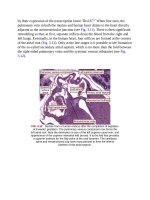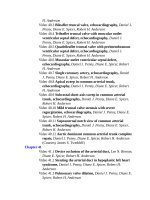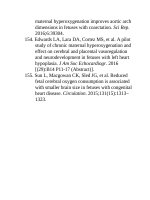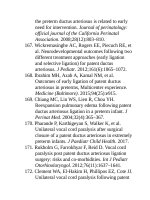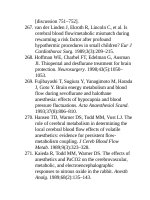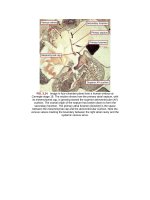Andersons pediatric cardiology 1091
Bạn đang xem bản rút gọn của tài liệu. Xem và tải ngay bản đầy đủ của tài liệu tại đây (121.92 KB, 3 trang )
Inviewoftheacknowledgedmorbidityassociatedwithsurgicalductal
closure,therehasbeenanincreasedinterestinclosingthepatentarterialduct
percutaneouslyinverysmallinfantswithweightsaslowas750g.193–199The
experiencewiththisapproachhasbeenincreasingoverthepastfewyears,with
encouragingresultsfromadiversenumberofcenters.Closurecanbeachieved
withcoils,194theMedtronicVascularPlug,195oroneoftheAmplatzerfamilyof
occluders.41,196–199Toreduceradiationexposuretothesefragilenewborns,
transthoracicechocardiographicmonitoringfortheimplantationlimitsor
eliminatesfluoroscopy,hasproveneffective,andallowstheproceduretobe
performedintheneonatalunit.197,199InthestudybyZahnetal.,199catheter
closurewasattemptedin24extremelyprematurenewbornsatameanageof1
monthandweightof1249g(range755to2380g).Therewerethreeprocedural
failuresrelatedtothedevelopmentofleftpulmonaryarterystenosisduetothe
device(AmplatzerAVPII),andalldeviceswereremoveduneventfully.The
deviceresultedinleftpulmonaryarterystenosisinoneinfant,requiringastent
infollow-up.Therewerenoproceduraldeaths,postligationsyndrome,residual
ductalflow,ordeviceembolization.Twenty-threeof24infantssurvivedto
discharge,withonelatedeathunrelatedtotheprocedure.Afteramedianfollowupperiodof11months,allinfantswerealiveandwell,withnoresidualductal
floworevidenceofpulmonaryarteryoraorticcoarctation.
Nevertheless,overallmortalityremainshighbutmoreoftenisrelatedto
continuingrespiratorydistress,intracranialhemorrhage,necrotizing
enterocolitis,orcoagulopathy,ratherthanthetherapiesthemselves.177Outcomes
arealsoinfluencedbythedurationofthewaitingtimeforsurgery/catheter
interventionafterfailedmedicalmanagement,perioperativecare,andinsome
situationstheneedforpotentialtransporttofacilitieswithsurgical/catheter
capacity.200Manyquestionsremainunansweredconcerningthetrueimpactofa
largeleft-to-rightductalshuntonthecourseandoutcomeofprematurityand
respiratorydistresssyndrome.136,201Indeed,overthepastdecade,neonatal
intensivecareunitshaveseenasignificantdecreaseinthediagnosisand
treatmentoftheprematureinfant'sarterialduct,withlittleevidenceofan
increaseinmorbidity.202Inalargemulticentertrial,one-thirdofinfantswitha
significantducthadspontaneousclosure,andindomethacin-inducedclosurein
70%ofinfantstreated.Therewasnodifferenceintherateofclosureif
indomethacinwasgivenimmediatelyondiagnosisorafter48hoursofintensive
medicaltherapy.Ratesofdeathwereidenticalinpatientstreatedwith
indomethacinearly,withindomethacingivenlate,orwithsurgery,being
approximately13%overallineachgroup.203
InfiltrationofFormalin,BalloonDilation,
ImplantationofStents,andBioengineeringof
theArterialDuct
Rudolphandcolleagues204describedatechniqueofsubadventitialformalin
infiltrationofthewalloftheductdesignedtomaintainlong-termpatencyofthe
vesselinpatientswithduct-dependentcardiacmalformationsinwhomsurgery
waseitherinadequateornotfeasible.However,itwasshownthatinfiltrationof
formalindidnotensureductalpatencyevenforashorttime.205Thetechnique
wasabandonedinfavorofinfusionofprostaglandinE1.
Percutaneousballoondilationhasalsobeenproposedasamethodtomaintain
ductalpatency.206Temporarypatencycanbeachieved,butabruptclosure,
thrombosis,orrupturecanoccur,makingthisalessreliablemeansofassuring
patency.Exceptforspecialinstances,thistechniquehasnotbeenpursued
clinically.
Toprovideamechanicalscaffoldfortheductalwall,resistanttothe
constrictiveforcesofductalclosure,CoeandOlley207proposedtheimplantation
ofendovascularstents.Thisapproach,usingeitherself-orballoon-expandable
stents,hashadexpandingclinicalapplication.Theimplantationinanatomically
uncomplicatedducts,suchasinpulmonaryatresia,criticalpulmonarystenosis,
orthehypoplasticleftheartsyndrome(Fig.41.19;video41.2),hasbeen
encouraging.208–212However,useinmorecomplexsituations,suchasoccursin
tetralogywithpulmonaryatresiacanbetechnicallydifficult.213Withinnovative
approachestodelivertheimplant,suchascut-downofthecarotidarteries,
transvenousthroughaventricularseptaldefect,orafterradiofrequency-assisted
balloondilationofanatreticpulmonaryvalve,theprocedurecanbeperformed
eveninductsthatoriginatefromtheundersurfaceoftheaortaoraretortuous
(Videos41.3and41.4).Largely,applicationhasbeenadvancedthrough
improveddesignofthestents,suchasflexibleballoonplatformsorsystemswith
lowerprofiles,ortakingadvantageofthepotentialofdrug-elutingimplantsto
alterthevesselreactivity,thusreducingin-stentstenosis.AttheHospitalfor
SickChildreninToronto,Leeandcolleagues214investigatedtheuseofa
rapamycin-coatedstentsimplantedintotheductofsmallnewbornpigs.The
meanluminaldiameterofbaremetalimplantscomparedwiththedrug-eluting
stentswassmallerby32%and42%at4and6weeks,respectively,byinhibition
ofneointimalformation(Fig.41.20).Inclinicalapplicationininfants,215such
ductalimplantssawpeakrapamycinlevels20timeshigherandclearance30
timeslowerthanreportedinolderchildrenandadults,withinthe
immunosuppressiverangeforprolongedperiodsbutwithnoobservable
clinicallysignificantadverseoutcomes.Althoughtheroleofstentsinthe
managementofinfantswithcomplexductal-dependentlesionshasyettobefully
defined,suchstudiesareverypromising.Thearterialductmayalsoserveasa
conduittodecompressthepulmonarycirculationinthesettingofidiopathic
pulmonaryhypertension.Reopeningandstentingtheducthasprovenefficacious
inthisclinicalsetting.216–218
FIG.41.19 Left,Infantwithhypoplasticleftheartsyndromeawaiting
cardiactransplantation.Theductbecamestenoticandunresponsiveto
prostaglandin.Pulmonaryarterialangiogramdepictsastentplaced
transvenouslyacrosstheducttorelievethestenosis.Right,Aortogramis
seenafterimplantationofastentinaninfantwithpulmonaryatresiaand
intactseptumwhowasprostaglandindependent.
